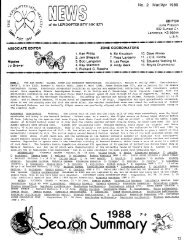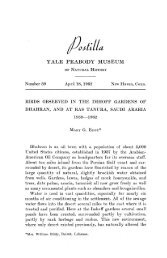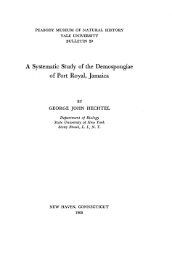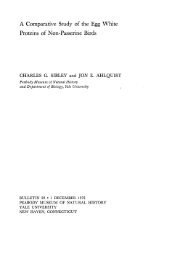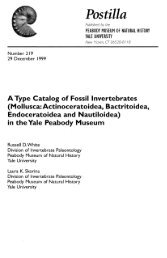Bulletin 3 - Peabody Museum of Natural History - Yale University
Bulletin 3 - Peabody Museum of Natural History - Yale University
Bulletin 3 - Peabody Museum of Natural History - Yale University
Create successful ePaper yourself
Turn your PDF publications into a flip-book with our unique Google optimized e-Paper software.
22 PEABODY MUSEUM OF NATURAL HISTORYThis summary reveals the consistency <strong>of</strong> inheritance in thetwo birds. Maturity might have brought out in the Mainehybrid one more character from Lophodytes (white tertialstripes), and two more characters <strong>of</strong> Bucephala (white scapularmarks, green iridescence on head).Of the 18 characters observed, 13 were similarly inherited byboth hybrids (1, 2, 3, 4, 5, 6, 7, 9, 12, 13, 15, 16, 18); 3 areuncertain because <strong>of</strong> immaturity <strong>of</strong> the Maine bird (8, 10, 11) ;one (17) follows Bucephala in the Maine hybrid, while in theNew Haven bird the character appears complete as in Lophodyteson one leg, and as in Bucephala on the other leg; finally, a singlecharacter (14), with due allowance for immaturity, is reversedin the two hybrids.One may now pr<strong>of</strong>itably compare with the Maine and NewHaven hybrids a few characters <strong>of</strong> Eimbeck's European hybridBucephala clangula clangula X Mergellus albellus described onan earlier page. This bird was a fine male in full plumage.One parent {Bucephala) was almost identical for all three birds.The other parent {Lophodytes) was identical for both Americanhybrids, but for the European was another species <strong>of</strong> black andwhite merganser, the smew. This species {Mergellus albellus)differs considerably from Lophodytes, especially in lack <strong>of</strong> crest,but resembles it in possessing two black crescentic bands on eachside <strong>of</strong> the white breast, and two white wing bars.Eimbeck's hybrid inherited traces <strong>of</strong> the black breast bars <strong>of</strong>Mergellus, the black head and green iridescence <strong>of</strong> Bucephala(wing bars not mentioned). Absence <strong>of</strong> crest is consistent withits absence in both parents.The striking feature, as contrasted with the two Americanspecimens, is the presence <strong>of</strong> a "white spot between the beak andeye.'* In this respect the Bucephala pattern dominated.Both Guyer (1909) and Phillips (1914) remark on the preponderance<strong>of</strong> males among hybrid ducks, especially in caseswhere the parents are distantly related. It is interesting to notethat all hybrids discussed in this paper are males.



